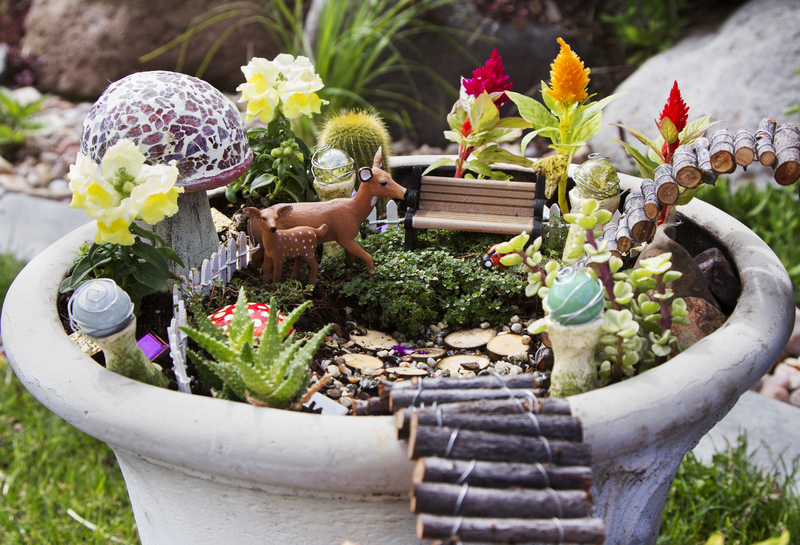Crafting a Warm Haven for Winter Plants
Posted on 16/09/2025
Crafting a Warm Haven for Winter Plants: Comprehensive Strategies for Success
As winter approaches, gardeners face a familiar challenge: keeping beloved plants safe from frost, freezing temperatures, and harsh winds. Crafting a warm haven for winter plants is not only an act of protection, but also an opportunity to extend your growing season, nurture delicate species, and ensure a lush, vibrant garden come spring. This article offers a comprehensive, SEO-optimized exploration into the art of creating cozy winter shelters, packed with *practical tips*, _innovative techniques_, and _environmentally friendly solutions_ for every gardener.

Why Winter Protection is Crucial for Plants
In many climates, winter brings plummeting temperatures and reduced daylight, both of which pose significant risks to garden plants. Many species, especially tropical varieties and young saplings, simply cannot tolerate cold stress, frost heave, or desiccating winds. Left unprotected, these conditions can lead to:
- Leaf and stem damage, resulting in poor growth or plant loss
- Root injuries from freezing soil
- Dehydration from cold winds and low humidity
- Reduced chances of spring recovery and flowering
Understanding the vulnerability of your greenery is the first step in crafting an ideal winter haven for plants, regardless of whether you're growing exotic flowers, fruit-bearing shrubs, or hearty perennials. *A safe winter greenhouse, cold frame, or even a well-made plant cover can make all the difference.*
Assessing Your Garden: What Needs Extra Winter Protection?
Not all plants are created equal when it comes to surviving the chill of winter. It's essential to know which specimens require extra care and how to prioritize your efforts.
Tender Perennials and Annuals
- Think geraniums, begonias, and dahlias. These plants love the warmth and do not naturally withstand frost.
- Tip: Dig up bulbs and tubers for storage indoors if possible.
Young Trees and Shrubs
- Immature root systems are more susceptible to cold injury.
- Wrap trunks with special tree guards, and mulch generously to insulate roots.
Potted and Container Plants
- Soil in pots freezes faster than ground soil. Move these plants to sheltered areas or indoors if space allows.
Exotic and Tropical Species
- These will rarely tolerate temperatures below 10?C (50?F). Consider greenhouses or heated sunrooms as a winter refuge for sensitive plants.
Fundamental Elements of a Warm Winter Plant Haven
To establish a truly effective winter plant shelter, several key elements should be addressed that contribute to the overall warmth, dryness, and health of your plants.
1. Insulation
Insulating your plants helps buffer them from sudden temperature drops. There are various ways to provide insulation:
- Mulching: Spread organic mulch (straw, bark chips, leaves) generously around plant bases to insulate roots, moderate soil temperature swings, and retain moisture.
- Row Covers: Use horticultural fleece or burlap to create a protective barrier that traps heat close to the plant.
- Cloche and Mini-Greenhouses: For smaller plants, plastic cloches, glass jars, or custom-built mini-greenhouses are ideal.
2. Wind Protection
Cold, desiccating winds can strip moisture from leaves and stems, increasing the risk of winter burn. Create windbreaks using:
- Garden Screens: Install wooden or plastic panels on the windward side of susceptible gardening beds.
- Evergreen Hedges: Planting thick, dense shrubs or trees acts as a natural wind barrier over the years.
3. Heat Retention
To establish a warm indoor haven for houseplants in winter, use passive solar techniques:
- Greenhouses and Sunrooms: Position these structures for maximum southern sunlight exposure. Utilize double-glazed windows for better insulation.
- Thermal Mass: Incorporate materials like water barrels or stone inside enclosed areas to absorb and radiate warmth during the night.
4. Moisture Control
Keeping plants dry while still watered enough is critical.
- Proper Drainage: Elevate containers off cold, wet ground with pot feet or bricks. Ensure garden beds are free from pooled water.
- Monitor Indoor Humidity: For indoor winter havens, increase humidity with water trays or humidifiers.
Step-by-Step Guide to Setting Up a Cozy Winter Plant Shelter
Ready to transform your winter landscape into a plant haven? Follow these actionable steps:
- Survey & Select
Identify the most vulnerable plants in your garden--tender perennials, containerized plants, seedlings, and exotics. Tag and group plants with similar winter requirements for easier management. - Clear and Prepare
Remove dead foliage, weeds, and debris around your chosen plants. This reduces hiding spots for pests and diseases that thrive during winter dormancy. - Apply Mulch & Barriers
Generously mulch at the base and consider using straw bales, old blankets, or specially designed wraps around trunks and stems for extra insulation. - Build or Set Up Shelters
Erect cold frames, cloches, or row tunnels over your beds. For container plants, group pots together against a sheltered wall to maximize shared warmth and provide cover. - Monitor Regularly
Check plant health weekly. Watch for signs of mold, rot, or dehydration. Adjust ventilation in covered shelters to prevent excess humidity.
Optimal Structures for Crafting a Warm Haven for Winter Plants
1. The Classic Greenhouse
Nothing rivals the efficiency and utility of a well-designed greenhouse. Whether glass or polycarbonate, these structures capture winter sunlight, hold in heat, and provide a controlled environment. For best results:
- Use double-walled panels to enhance insulation
- Add thermal curtains or bubble wrap to line walls for extra warmth
- Install temperature and humidity monitors for optimal climate control
- Consider solar or electric heaters for extremely cold regions
2. Cold Frames: Simple and Efficient
A cold frame is a low-cost, DIY-friendly alternative to a full greenhouse--essentially a box with a transparent lid. Ideal for overwintering seedlings and modest crops, cold frames empower you to:
- Spring-start seeds earlier
- Protect delicate greens throughout the coldest months
- Regulate conditions by propping open the lid on sunny days
3. Row Covers and Tunnels
Gardeners with larger vegetable plots often turn to row covers and low tunnels. These use hoops draped with heavyweight horticultural fleece or plastic, offering flexible and scalable protection.
- *Lightweight fabric allows air and rain to penetrate while trapping essential warmth*
- Plastic tunnel kits are reusable and can be dismantled in spring for storage
4. Indoor Havens for Houseplants and Tropicals
For treasured houseplants, craft an indoor warm winter sanctuary:
- Place near south-facing windows for maximum sunlight
- Group plants together to create a microclimate of higher humidity
- Supplement with grow lights during dark spells or if windowside space is limited
Advanced Tips to Maximize Winter Plant Haven Warmth
Utilize Passive Solar Energy
Position outdoor shelters or greenhouses where they receive uninterrupted winter sun. Add water barrels inside as thermal mass--they'll absorb heat by day and release it after sunset, helping smooth out nighttime temperature dips.
Create Reflective Backdrops
Install white-painted boards or aluminum foil behind plant beds or pots inside a greenhouse or sunroom to bounce sunlight deeper into the space.
Use Heaters Judiciously
If relying on electric or gas heaters, invest in a thermostat-controlled system to avoid overheating and waste. Choose energy-efficient models designed for horticultural use.
Monitor and Adjust Humidity
Plants may require higher humidity than a typical heated home provides in winter. Place pebble trays beneath containers or use small humidifiers. Watch for fungal issues; good airflow remains vital even when humidity is increased.
Eco-Friendly & DIY Approaches for Sustainable Winter Plant Shelters
Repurpose and Recycle
- Reuse old windows or shower doors to build cold frames
- Turn large plastic bottles into mini-cloches for sensitive seedlings
- Utilize cardboard and wool blankets as temporary insulators
Mulch Creatively
- Gather fallen leaves to use as insulating layers
- Compost straw and spent crops at season's end for next year's mulch
Utilize Natural Microclimates
- Position pots against south-facing walls to capture radiant heat
- Group plants together to share warmth, reducing heat loss per individual
Common Winter Plant Protection Mistakes & How to Avoid Them
- Insufficient Mulching: Skimping on mulch leaves roots vulnerable. Aim for a thick 2-4 inch layer for best protection.
- Overwatering Indoors: Plants need less water in winter due to slower growth. Only water when soil is dry an inch below the surface.
- Not Ventilating Covered Shelters: Without airflow, mold and mildew can thrive. On warm, sunny days, open cloches or greenhouse vents.
- Leaving Plants Exposed to Icy Winds: Always shield your most sensitive species from prevailing winter gusts with screens, fencing, or evergreen plantings.

Conclusion: A Season of Growth Starts with Winter Protection
Winter need not be a time of detachment from your beloved garden. With the right tools and techniques, crafting a warm haven for winter plants becomes a deeply rewarding endeavor. By sheltering your greenery from harsh weather, you safeguard their health, boost their resilience, and set the stage for spectacular growth when spring arrives.
Whether you opt for a full-featured greenhouse, resourceful cold frames, or simple DIY plant covers, the essentials remain the same: insulate, protect from wind, manage moisture, and maximize natural warmth. With a little planning and creativity, your landscape--or indoor jungle--can thrive even as winter rages outdoors. Give your plants a cozy, nurturing haven this winter, and enjoy the flourishing results for months to come.
FAQs: Crafting a Warm Haven for Winter Plants
How often should I check my winter plant shelter?
During cold snaps, check every few days for frost, mold, or water needs, especially after storms.
What's the best mulch for winter insulation?
Straw, shredded leaves, bark chips, and compost all work well--choose what's locally available and avoid using peat, which can repel water.
Can houseplants stay outside in winter?
Most common houseplants, especially tropicals, should come indoors before night temperatures dip below 10?C (50?F).
Is it worth building a greenhouse for only a few plants?
Consider more compact options: cold frames and mini greenhouses are affordable alternatives and perfect for smaller collections.
Start crafting a cozy winter haven for your plants today and ensure your garden's year-round beauty, life, and success!

